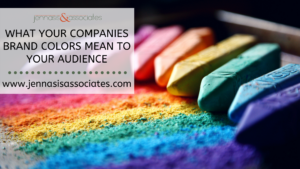Did you know that your brand’s colors can tell more about your business than you could even imagine? Your brand colors can elicit emotions that may help your company establish trust with your audience. Many of the most well-known brands in the world have a strong association with their logos. This is due to the power of colors and the reactions that they may provoke. Studies have shown that a product’s color influences 60-80% of a customer’s purchasing decision, so the right choice of color not only strengthens the brand, but it can also affect your total sales.
When thinking about branding and building your brand strategy, it’s important to look at how the psychology of colors can affect the message your audience perceives about your company’s brand. You should integrate your brand’s colors across your website, in your logo, brochures, social media, and any other business collateral you’re putting out there. A strong brand image increases the impact your brand has on the success of your business.
Let’s take a closer look at the colors and how each market can use them to connect with their audience with these branding best practices.
How do colors evoke different emotions?
- Yellow: happiness, cheerful, energetic
- Green: health, nature, growth, balance, organic
- Blue: compassion, inspirational, spirituality, trust
- Purple: luxury, thoughtfulness, creativity
- Red: love, passion, intensity, motivation, determination, courage
- Orange: fun, friendly, positive vibes
- Pink: feminine, affectionate, romantic, nurturing, delicate, youthful
- White: pure, renewal, simple, clear, spacious, sophisticated
- Grey: sophistication, classic
- Brown: organic, earthy, dependable, honest, reliable, masculine
- Black: modern, classic, elegant, powerful
Now that you know the basics of what emotions different colors can evoke, it’s time to start creating your brand’s look. Here are a few questions to think about first, if you haven’t already:
What does your brand stand for? What are your core values and beliefs? Come up with at least 5 core values that your brand stands for. These values need to show through the way your brand speaks, the way your brand looks, and how you deliver your brand to the world.
How do you want your ideal audience to feel? What emotions do you want to evoke in your audience to get a response? Pick 3-5 emotional words!
What is your brand’s personality related to you and your ideal audience? Now it’s time to put it all together. Your brand’s personality is really who you are. Remember this will draw your ideal audience.
How do you build a good brand color scheme?
Obviously, there are many different ways to come up with your brand’s color scheme. Here are a few ways to make the process a little less daunting. Plan on choosing 3 colors: a base, accent, and natural.
Choose your base. Of all your brand’s traits, what is the most important? What color from the list above displays what you are trying to convey to your audience? You’ll choose the remaining colors based on this one.
Choose your accent. This is the color you will use the most after your base color. This may be harder to select because it must pair with your base color’s meaning and in a visual sense.
Choose your neutral. Most likely a background color, this color is chosen to avoid attention. Typically these tend to be shades of gray, beige, tan, or white.
What are brand color schemes?
Monochromatic: When you have one personality trait you want to focus on, this scheme will emphasize the meaning of that one brand color.
Analogous: Colors next to each other on the color wheel. These are often harmonious since adjacent colors usually have similar emotional connotations.
Complementary: Colors that are opposites (directly across from each other on the color wheel) tend to bring out the best of each other when they are paired. These are harder to find a pair to stand out with since they are the most popular, so many other brands may have the same color combinations as you.
Triad: Triadic colors bring 3 equal parts of 3 different sections of the color wheel together for stable branding. While stimulating, the hardest part of this scheme is getting the 3 colors to match your brand’s personality traits.
Moving Ahead
While it’s useful to understand the psychology of each color while creating your brand’s identity, your color choice can build your company’s brand while bringing you closer to your target audience. Use colors that will showcase your brand’s strengths, and evoke the right feelings for your audience.
Need help with selecting the right brand colors or figuring out what direction to take your brand? The Jennasis and Associates branding agency is here to help! Jennasis & Associates is a digital marketing and branding agency that can help you with social media management, branding, and content marketing so that you can focus more of your time and attention on managing the areas of your business or organization that make the most sense. Contact us today to learn more about how we can help.
Do the colors you have chosen for your brand align with the feeling you’re trying to give your customers and prospects? Tell us why you chose the colors you did for your brand in the comments.






